Customer story: Cartrefi Cymru
Over £300k in admin savings, 400h+ in agency time reduction, and increased staff wellbeing - see how large supported living provider, Cartrefi, did it.
Building a staff schedule couldn’t be easier.
Reduce payroll errors with real-time T&A.
Fill 50% more shifts with your own employees.
Ensure shifts are covered even if you're understaffed.
Manage absence requests and approvals.
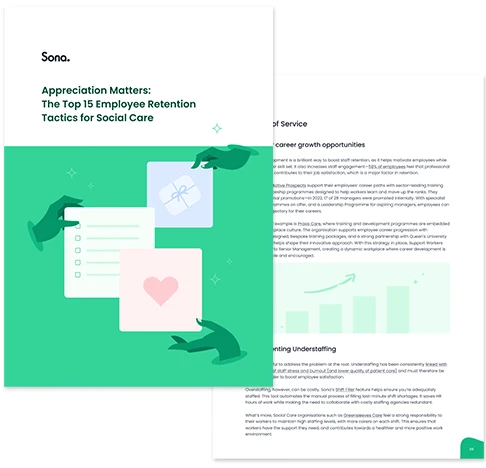
Practical ways to boost team morale with proven examples from across the sector.

Find out what care employees say matters to them most at work.
Search and view employees with customised permission levels.
Key employment information all in one place.
Store visas, professional certifications and more with easy access.
Control personal and operational details of your staff.
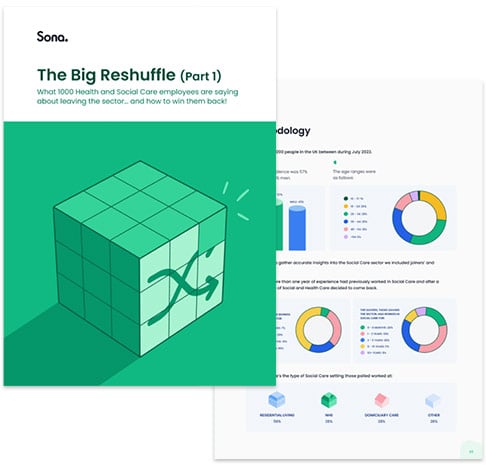
Why are people leaving Social Care, and where are they going?
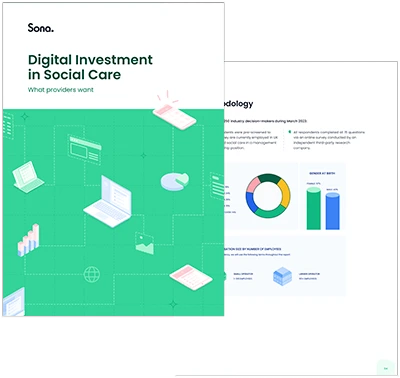
We asked 250 Social Care leaders about their attitudes towards digitisation and their plans for the next 12 months...
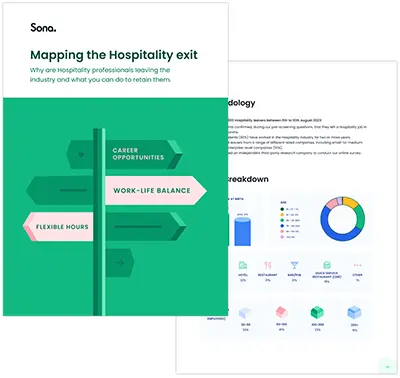
Why are Hospitality workers leaving the industry, and what can you do to retain them?
Share updates with a single click.

Staff can see relevant messages in one place.
Request post-shift feedback from staff.
Recognise staff contributions by sending them praise.
Identify staff at risk of churning.
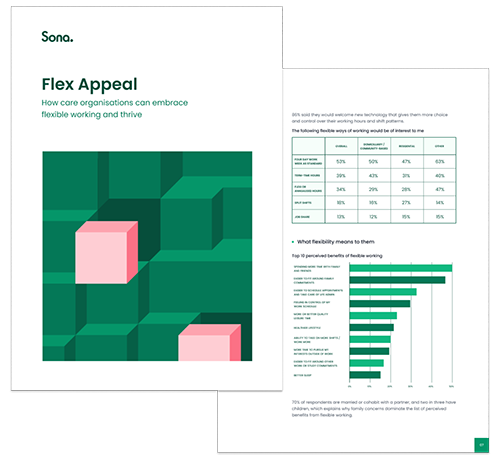
How care organisations can embrace flexible working and thrive.
Maintain quality of care and reduce costs.
Maximise profitability through AI-powered forecasting & scheduling.
Elevate your operational efficiency and guest satisfaction.
Streamline operations across sites.
Developed alongside Social Care experts with decades of combined experience.
See why we are the leading user-friendly, end-to-end platform that prioritises both efficiency and wellbeing.
The Sona Partner Network is an ecosystem of solution experts and complementary technologies.
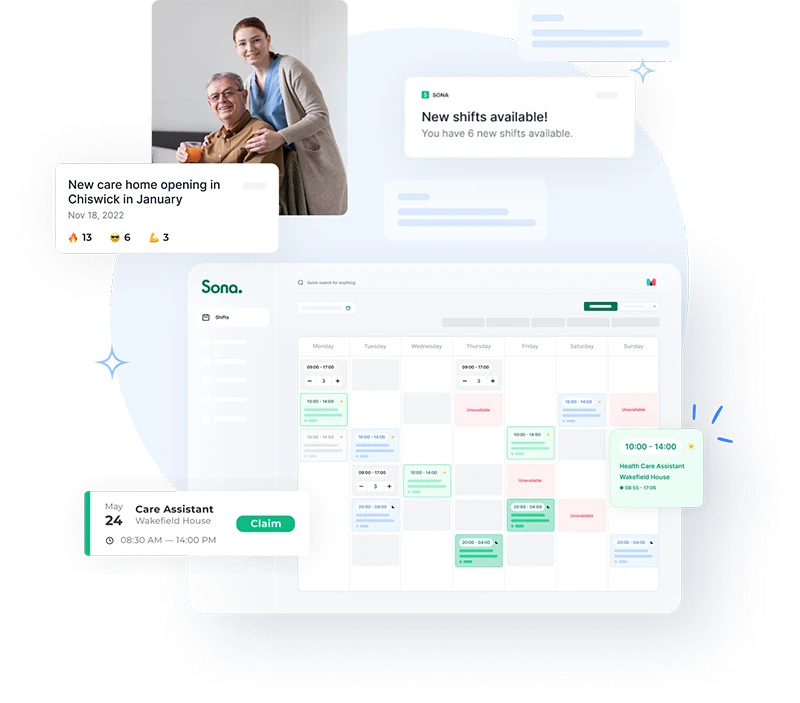
Give staff greater visibility of shifts available to work, with a simple "shift claim" process to increase their income.
Improve employee engagement and retention with a seamless employee communication platform.
Happier staff provide greater customer experiences, which in turn drives return rates, revenues and recommendations.
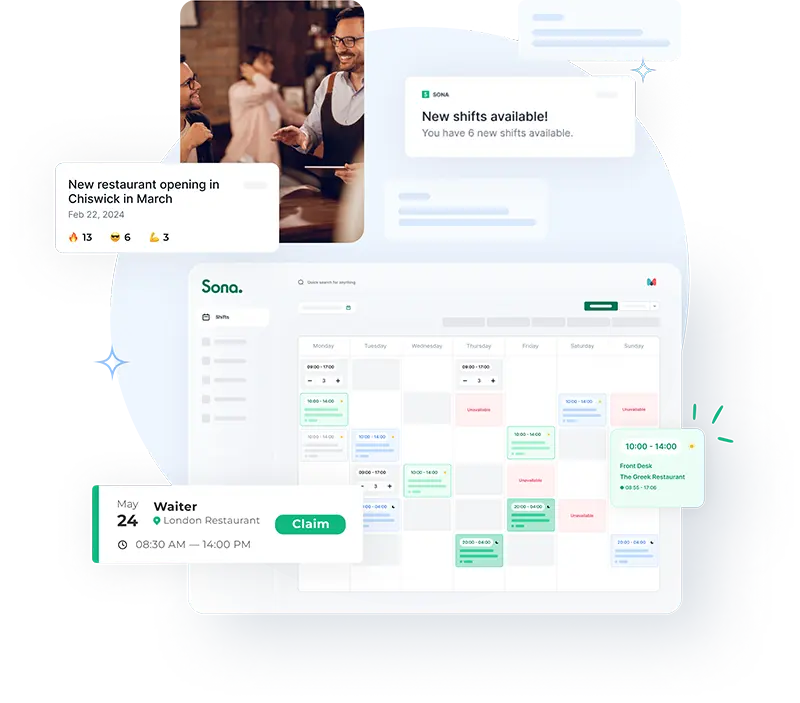
Give staff greater visibility of shifts available to work, with a simple "shift claim" process to increase their income.
Improve employee engagement and retention with a seamless employee communication platform.
Happier staff provide greater customer experiences, which in turn drives return rates, revenues and recommendations.
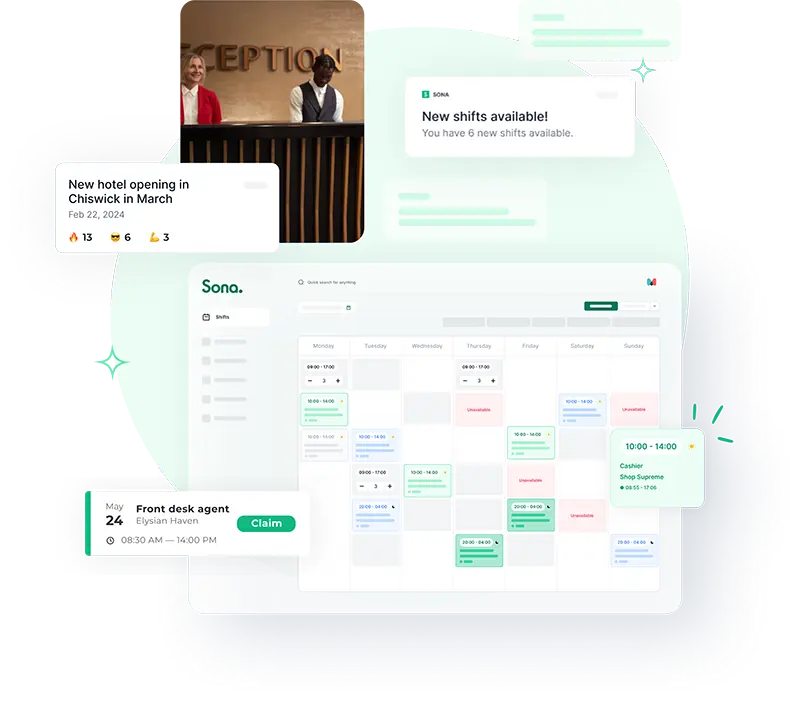
Meet the Sona team online with our webinar series or in-person at an event near you.
New research, insights, and strategies for frontline leaders.
Downloadable templates, reports and guides from Sona.
Stay up to date with the latest Sona news and research.
Learn how our customers are transforming their people operations.
| 1 min read
Over £300k in admin savings, 400h+ in agency time reduction, and increased staff wellbeing - see how large supported living provider, Cartrefi, did it.
| 1 min read
Over £200k in annual savings, 80h+ in saved admin time, and increased staff wellbeing - see how large supported living provider, Perthyn, did it.
| 1 min read
Yorkshire Care Group has experienced 60% growth in its operational capabilities over the last 18 months, and is well on-track to achieve 300% growth over the course of five years.
PUBLISHED: February 2025
Download the report to learn how hospitality operators are embracing AI challenges and opportunities in 2025.
PUBLISHED: January 2025
Reveal the most important metrics in 2025!
PUBLISHED: December 2024
This infosheet is packed with practical insights to drive high-quality, low-regret WFM purchases.Geraint Jenkins
Chief Executive Officer
Contents
Sona felt so modern. It felt really adaptable - it's like the Netflix approach to rostering. You turn it on one day, and there's an update and there's a message to tell you what the update is. That takes a lot of the pain away in terms of planning big upgrades.
Geriant Jenkins, CEO
Cartrefi is a registered charity that provides support primarily to people with a learning disability, across Wales. They support around 650 individuals with the help of over 1250 frontline members of staff.
In rolling out Sona’s Scheduling, HR, Payroll, and Wellbeing products, they had a clear goal: give back time to their managers so they can focus on care, remove overspend without affecting quality of service, and increase team wellbeing.
Chief Executive Officer and Sona project lead, Geraint Jenkins, believes they’ve succeeded on all accounts and are now in a better place to tackle the challenges 2025 will bring.
What sold it to us is the pressure the whole sector's under. These days it's not uncommon for one service manager to be managing four services with four different teams. That meant that their time and capacity to do value work - helping colleagues and the people we support - has been eroded through time consuming administrative processes.
I was keen on putting that capacity back into frontline managers, so that they had more time to do the value work and focus on innovative solutions. And when we did some rough sums [on how much time Sona released back] - if we save five hours from every service manager, that adds up to just shy of £300k a year equivalent which is a really solid investment, providing you've got the cash flow to sustain it.Geraint Jenkins, CEO
In terms of benefits, Cartrefi has seen:
Cartrefi's leadership was also motivated to reduce agency costs and improve consistency of care by better deploying their colleagues despite the challenge of covering some of the most rural areas of Wales.
Implementing an agency usage report, where managers have to add reasons for booking agency staff, and enabling permanent team members to pick up extra shifts easily via the Openshift Marketplace, meant that Cartrefi could ensure agency help would only be used when truly needed.
It just simplifies and standardises, but it gives us really good organisational oversight. We haven't got a massive amount of data on that yet because it's still early days, but using the baseline in the last five weeks alone, we've saved over 400 hours in agency.
This might not seem a lot, but when you look at us as a whole organisation, so many of our services are rural. To be able to staff and recruit for these rural areas, it's a nightmare. So we have to rely on agencies. Even when it's come down a little bit, 400 hours is massive.
Cath Lamprey, Programme Change Manager
Initially, the Cartrefi team was considering Scheduling only as their first WFM product, but after assessing their change capacity, they realised an end-to-end product would better suit their needs.
Because we managed change quite slowly in Cartrefi and taking people on that journey was resource heavy, we felt that if we're going to do it, we do it all in one go.
Geraint Jenkins, CEO
Generally, an end-to-end product would mean less configurability, but thanks to Sona's flexible design and modular approach, the Cartrefi team had access to best-in-class systems for Scheduling, HR, and Payroll, respectively.
Sona was fantastic because we didn't just have to buy this out-of-the-box project that we didn't really want. They let us build the HR system completely tailored to our needs.
Cath Lamprey, Change Process Manager
A 24/7 supported living model for adults with learning disabilities meant that Cartrefi had a wide variety of shifts, locations, and skills required for each individual they support. They were keen to find a Care specific scheduling tool that could handle their complexity whilst still being accessible to all managers and colleagues.
This meant going agaisnt the grain when looking for a product and prioritising a Scheduling solution that communicated perfectly with HR.
We prioritised the functionality between Rostering and HR. This was a bit unconventional for the sector because normally when you're looking for these solutions, you'll be sold something that does rostering, care management and recording.
And for us, that was the wrong way around. Our care planning and values around delivering support are so niche and so specific that we would never fit ourselves into a "vanilla" box offering. For us, having rostering and the people based systems combined made loads more sense.
Sona's offer really understood what we were about and how sites work and how niche requirements work, particularly nighttime cover and sleep cover. All of these nuances were really thought of in the product and the offer was really in line with what we needed.
Geraint Jenkins, CEO
Geraint Jenkins was Cartrefi's CTO before moving into the CEO position as the Sona project unfolded. He had strong views on the importance of high quality integrations and what these should look like.
Integrations are key, but I believe the success of our integrations lies in their simplicity. Often, integrations attempt to offer too much and fail to provide the essential functionality we require. However, when you closely examine what an integration or API truly needs to deliver, it's usually not a lot, but the small part it does is vital.
Synchronizing to eliminate duplicate entries is incredibly useful for us. It cuts down on administrative time. I believe Sona has done really well by focusing on the core functionality. It's crucial to identify what's truly important in that integration and execute it well.Geraint Jenkins, CEO
Currently, Cartrefi is using the Sona & Nourish integration and will soon have access the new Talos (Applicant Tracking System) integration.
We're looking forward to the roadmap. The next thing we probably want is the the learning development system. It'd be interesting to see how that plays out in the future. But that's the nice thing about knowing a tech stack is willing to support APIs and develop integrations - it just gives you peace of mind that you can stick with a solution for much, much longer because you've got that flexibility.
Geraint Jenkins, CEO
With over 1,200 staff, including 900 support workers, Zoe's finance team is under constant pressure to manage complex operations, ensure compliance, and maintain accuracy.
That’s why the adoption of Sona has been a turning point. Though she wasn’t involved in the original decision to implement Sona, Zoe is now a strong advocate for its potential.
I think Sona will pay for itself. It's not just the savings and the capacity we'll get back from the payroll. I think the rostering, our teams being able to pick up shifts, reducing the agency costs - we spend a lot of money on agency at the moment - and just having a more streamlined process.
Zoe Jones, Director of Finance & Digital
Beyond efficiency, Sona’s real-time dashboards give Zoe’s team accurate, service-level labour cost insights and the ability to evidence hours more easily with local authorities and boards.
“It’s going to be a game-changer for reporting to the board,” she adds. “No more spreadsheets—just live, consistent data in one place.” For Zoe, Sona isn’t just a tech solution; it’s a step toward a stronger, smarter organisation.
Alison, Director of People at Cartrefi, spoke candidly about the evolving challenges within the organisation, particularly around complexity and scale.
Throughout her tenure, she’s led a transformation initiative to create greater consistency and alignment across the business.
One of the biggest challenges, she explained, is managing variation across sites—whether in training, recruitment, or operations. The recent rebrand Cartrefi went through was about more than just a new name; it marked a shift toward building a unified culture and a compelling employee value proposition that supports both frontline and support staff.
To support this shift, Alison sees Sona as a key enabler. She highlighted the importance of empowering managers with the tools and data they need to make good decisions, while also creating a better experience for team members—many of whom are part-time and want greater flexibility and wellbeing.
There are some really key metrics that we're looking to use as part of the people strategy. Primarily they're around recruitment, retention, and sickness absence. We haven't had accurate sickness data previously. We've started using the reporting within Sona and we can see a real change in the trends already.
But it also enables us to support colleagues sooner, help their wellbeing. It's really great that colleagues can report on how they feel at the end of the shift and we can use that to inform a better people strategy.
Alison Woodward, Director of People
With Sona, Alison expects to reduce reliance on emails, streamline communication, and bring greater clarity to scheduling and resource management.
For her, it’s not just about operational efficiency—it’s about fostering a values-led culture where people feel connected, supported, and part of something bigger.
As Assistant Service Managers, Abbie and Heidi's daily responsibilities include managing staff, ensuring the quality of their service, and overseeing a smooth operation.
Prior to digitising, the administrative tasks, especially writing plans and risk assessments, consumed much of their time, leaving little room for direct interaction with the people they supported.
One specific thing they wanted to highlight was how easy the transition to digital was, even for those members of staff who were more apprehensive about the changes.
People tend to be a bit set in their ways. We have a few staff members who weren't keen at first. However, once we sat down and explained the process and they completed their training, I believe if you asked them now, they'd agree it was definitely for the better.
Abbie, Service Manager
If you talk to my team, they speak very positively about Sona and how everything is convenient and accessible. It's much easier for them, they can check their own annual leave and other things, which is helpful.
Heidi, Assistant Service Manager
Now, with everything digitised on Sona, they’ve seen a significant reduction in time spent on these tasks. Heidi estimates that they save about 50% of the time previously spent on paperwork, allowing them more freedom to be present with their teams and the people they support, which means Cartrefi has now achieved the goals they's set before rolling out their new end-to-end workforce management solution.
Enjoyed this Customer Story? See how Sona can help your organisation!
Let us know your number and we'll call you soon.
Arrange a Zoom call at a time to suit you.
Drop a line to our co-founder Oli - he'd love to hear from you.